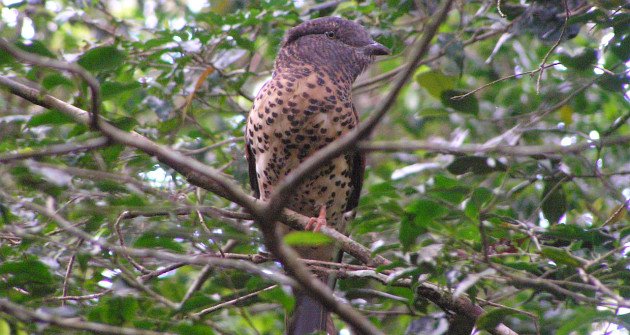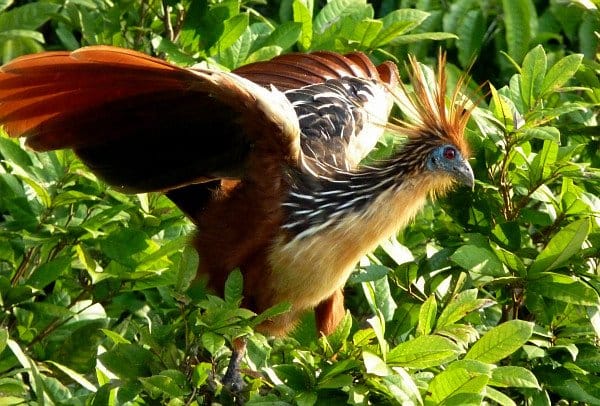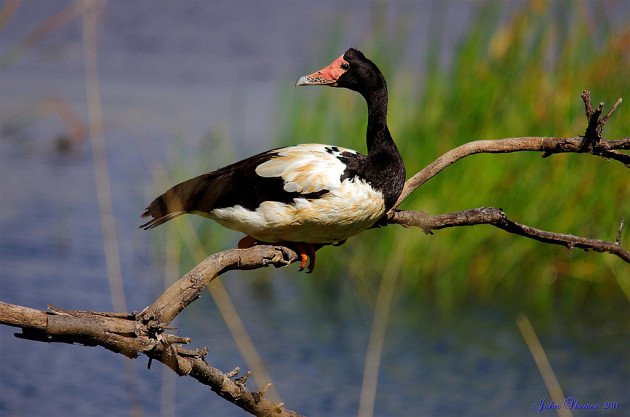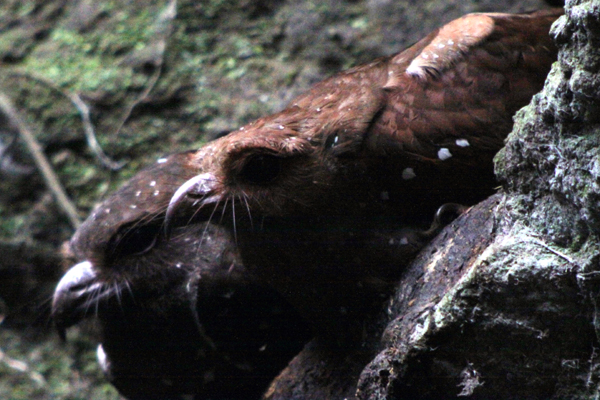
What are the world’s most distinctive birds? That question could be answered in several ways, but a new paper released this month — Global Distribution and Conservation of Evolutionary Distinctness in Birds (Jetz et al. 2014) — attempts to answer it by ranking species according to their “evolutionary distinctiveness,” or how distantly related they are to all other living birds. The ranking was done for the purpose of conservation triage, and it’s gotten quite a bit of media attention, for example, Brandon Keim’s Wired story.
While the ranking is limited by our current knowledge of the fossil record and the state of genetic sequencing techniques, it certainly spotlights some fascinating and enigmatic global treasures with unique physiologies and lifestyles.
It’s important to understand that the evolutionary distinctiveness ranking proposed by Jetz et al. is not primarily a measure of the divergence dates of major clades of birds but rather of individual living species. For example, the split between the ratites and all other living birds is very ancient, the earliest split that still has living members on both sides. But you won’t find Ostrich or another ratite in first place on Jetz et al.’s list because those birds have closer living relatives than some other birds do, despite their membership in the oldest extant group.
Since we’re talking relative age for a moment, even the next split, the split between Galloanserae (waterfowl and gallinaceous birds) and Neoaves (all other living birds), seems to have occurred when sauropods still dominated the earth and pterosaurs ruled the skies. Then at some point, Neoaves underwent a rapid diversification — one of the reasons it’s so difficult to settle the higher-level systematics within the group — and while current evidence points toward a rapid diversification after the K-T extinction, it does seem that some neoavian lineages diverged before the end of the Cretaceous, which brings us to the number one species on Jetz et al.’s list.
1. Oilbird (Steatornis caripensis)
The Oilbird‘s ancestors appear to have diverged from all other birds before the cataclysm that wiped out the non-avian dinosaurs, the pterosaurs, and countless other forms of life. It’s a bat-like cave-dwelling, echolocating, fruit-eating nocturnal species capable of hovering on three-foot wings. The Oilbird today lives only in South America, but fossils of similar species are known from Wyoming. Based on current genetic and morphological evidence, it seems that Oilbird is an early offshoot of the branch that eventually gave rise to potoos, frogmouths, nightjars, owlet-nightjars, swifts, and hummingbirds. In addition to Corey’s photo below from his trip to an Oilbird cave in Ecuador, check out these additional remarkable Oilbird eyecandy images.
Oilbirds (Steatornis caripensis) in Ecuador © Corey Finger
2. Cuckoo Roller (Leptosomus discolor)
The Cuckoo Roller — today found only in Madagascar and Comoros — is an oddball bird with a puffy head and a chameleon-eating habit. The sexes are dimorphic (here’s a fetching male), and nobody seems quite sure what this bird’s closest relatives are. It’s not a cuckoo or a roller, and as Darren Naish summarizes, it is the only survivor of an ancient neoavian lineage — hence its position at number two on this list.

Female Cuckoo Roller (Leptosomus discolor) cc-by Frank Wouters
3. Hoatzin (Opisthocomus hoazin)
Ah, the Hoatzin, which seems as likely to have been dreamt up by Lewis Carroll as anything, given its truly mind-bending looks and habits and the fact that we still have no idea what its relationship is to the other neoavian birds. I wrote about the Hoatzin here a couple of years ago when Gerald Mayr published a paper hypothesizing that Hoatzins invaded South America from Africa by raft. The story just keeps getting better.

Hoatzin (Opisthocomus hoazin) by Carine06
4. Magpie Goose (Anseranas semipalmata)
The large, pied, knob-headed Magpie Goose of Australia and New Guinea is the sole living member of an early anseriform waterfowl lineage. Note that while the magnificently bizarre screamers represent an even older anseriform offshoot, they didn’t make the top spots on the list because the extant screamer species are relatively more closely related to each other than the Magpie Goose is to anything else alive today. The Magpie Goose has only partially webbed toes, as hinted in the image below.

Magpie Goose (Anseranas semipalmata) cc-by-nd John Skewes
5. Secretarybird (Sagittarius serpentarius)
The spectacular African Secretarybird comes in at number five on the list. It is related to hawks and eagles, but only distantly, with an estimated divergence date not long after the K-T extinction. The Secretarybird is a powerful, long-legged terrestrial hunter particularly well known for killing snakes by stamping them to death but also perfectly happy to consume other animal prey.

Secretarybird (Sagittarius serpentarius) in Kenya by David J. Ringer
Coming in at numbers 6-10 on the list are Giant Ibis, Osprey, Kagu, Sunbittern, and Rufous Potoo. The paper — plus charts, tables, and supplementary materials — is open access here.














I sense a new kind of list-driven birding coming on.
Let’s see, I’ve seen numbers 3, 4, and 5. Number 1 shouldn’t be hard because there are people who will lead you right to them. Number 2 looks not too hard too, as long as you get yourself to Madagascar. But what’s a Giant Ibis?
(googles…)
Yikes, almost extinct and only in Vietnam. Well, maybe there are people in Vietnam who will lead you to them too.
The giant ibis is is an odd choice. Sure, it’s a unique genus, but it’s still an ibis. Surely there is another monotypic family, like the stitch bird? I’ll have to read the paper.
And Paul, if you want to see a Giant Ibis, go to Angkor Wat in Cambodia. Then you can do this awesome trip.
http://www.samveasna.org/tours/critical-cambodia:-tmatboey-ibises–veal-krous-vultures-and-florican-grasslands.html
Duncan, estimated divergence time for Giant Ibis is around 50 mya; Stitchbird is “only” 30-odd mya if I’m not mistaken. That’s what the rankings are based on.
I had no idea ibis were that old, and that deeply branched.
Still, it seems very odd to include a member of a ‘family’ with multiple living species. Also, you have to take those estimates with a grain of salt, especially one positing that oilbirds diverged in the Cretaceous. An overall radiation of at least Neoaves in the earliest Cenozoic is more likely, with current knowledge of the fossil record. There simply are no unambiguous neoavians from the Cretaceous.
Also, why on earth is the Rufous Potoo considered more ‘unique’ than the ostrich? That’s really odd. I’m not exactly sold on *Sagittarius* being more unique than ostriches either. Sure, there are other ratites around, but it seems likely that *Sagitarius* is more closely related to accipittrids and *Pandion* than ostriches are to other ratites! The only way not to include it here is by ascribing to the hypothesis that *Struthio (camelus) molybdophanes* is a distinct species, thus giving ‘the’ ostrich a close living relative.
Some other candidates definately worthy of consideration (if Giant Ibis and Rufous Potoo qualify, of all things) are the Crab Plover, the Plains Wanderer, the Hamerkop and the Shoebill. I know their closest living relatives are known and are probably not very distantly related either, but they certainly seem to be more unique than any ibis or potoo.
As for the other 4 in this top 5, they seem like good choices.
Brian, you are certainly correct that the divergence estimates are constrained by scientists’ current understanding of both the fossil record and genetics, and as the authors themselves have said, they expect this ranking to continue to change as we gain more information and better analytical techniques.
But again, Jetz et al.’s list is based on massive and complex calculations of known and hypothesized genetic information and fossil data to yield estimated divergence dates, not on a subjective sense of which birds “seem” more diverse.
Here’s a direct link to the figure that shows the top-ranked species by divergence dates — and you’ll see that Ostrich, Hamerkop, Shoebill, and Plains-wanderer all do score highly: http://www.cell.com/cms/attachment/2012528686/2034711936/gr1_lrg.jpg.
Regarding divergence dates for the neoavian lineages, Ericson et al. (2006), on whose work Jetz et al. partly relied, found that there is some support for initial — but not extensive — neoavian radiation before K-T: http://rsbl.royalsocietypublishing.org/content/2/4/543.abstract.
And Mayr, in his 2009 book Paleogene Fossil Birds wrote, “Given the fact that the Paleocene fossil record already includes such morphologically disparate taxa as Sphenisciformes (penguins) and Strigiformes (owls), there can, however, be little doubt that stem lineage representatives of some taxa of crown group Neoaves were already in existence in the late Cretaceous.”
But yes, we do need more fossils!
It also depends on what you consider to be species. For example if you split Osprey into Eastern and Western species, as some people like to do, then they plummet down the list from #6 because now they have close relatives, namely each other.
Yes, that’s right. Same thing if you split the Cuckoo Roller into two or more species in the Comoros. Here’s the authors’ description of how they arrived at their species list: http://www.cell.com/action/showExperimentalProcedures?pii=S0960-9822%2814%2900270-X